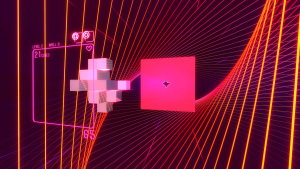The new PlayStation VR is incredible immersive fun, fulfilling a promise that’s as old as the video game industry itself.
In the early days of home video game consoles, advertisers for Atari and Commodore computers hawked their wares under a recurring theme: Immersion. The wording of the promise varied from game to game, but the message was always clear: If you buy this, then you get to inhabit the world we’ve built for you.
Print ads filled comic books with pleas for players to answer important calls to action:
E.T. needs YOUR help!
Raiders of the Lost Ark, STARRING YOU!
Become a Jedi Master without ever leaving your home.
The imagery that accompanied these ads depicted wide-eyed gamers surrounded by pixelated spaceships, dragons, and race cars. Look! They really are in the game!
With home video game systems being a relatively new commodity at the time, it made a lot of sense to advertise them this way. Before the Atari age, most gamers had to get their fix in arcades where you had to wait your turn to hop on the stick and could play only as long as you had quarters in your pocket. The prospect of being able to play in the comfort of your own home, and being able to do so indefinitely, was revolutionary. And if you’ve ever embarked on a gaming marathon that stretched into the wee hours of the morning, you know that those ads weren’t exactly misleading; there is a kind of immersion that happens over the course of time, where the real world fades away and your mind is focused only on the screen in front of you. It’s the same kind of truly great escapism that happens when a novel sinks its hooks deep into your bones, or when a movie captures your imagination, or when you binge watch four seasons of a show in one weekend. For gamers, getting to control the action added to the immersion and escape, even if the images on the screen at the time were quite crude.
But as technology has improved with alarming speed and triple-A games tell stories with production values that rival or surpass much of what Hollywood has to offer at the movie theater, that’s not the kind of immersion or escapism we’re talking about anymore. In short, we’re still after the original promise of those early advertisements. We want real immersion.
Enter the world of virtual reality, where a headset that provides a full, omni-directional view of the gaming environment while blocking out all light from the outside world can create just such an immersive illusion. You know you’re still sitting on your couch or standing in your living room, but your eyes are telling your brain a different story, and it creates a whole other level of involvement. VR technology isn’t new, but its proliferation is. And this week sees the release of the most affordable mass-market VR headset to date, the PlayStation VR, or PSVR.
Compatible with the PS4, the PSVR retails for $399 for the headset itself. If you don’t yet have the necessary PlayStation camera and a pair of Move controllers (the original ones from the PS3 are compatible), you’ll need to get a bundle of all the necessary hardware which will run you $499.
To cut to the chase: Yes, the PSVR is an incredible piece of hardware and playing most of the games on its launch lineup will give you some memorable moments. But to help you render a final verdict as to whether or not the asking price is worth it, here is a breakdown of everything you’re getting yourself into when you jump into the world of PSVR.
THE HARDWARE/SETUP
The PSVR headset itself is a lightweight band of white plastic with a soft foam interior. To slide the headset on, you just press the release button on the back of the band and stretch it over your head. As you release the button, the band shrinks to your head. You can then tighten it for a perfect fit with a turn of a dial. The visor, which houses all of the optical tech, is surprisingly lightweight. Its outer edges—and the little nook where you nose rests—are rimmed with thin black rubber to block out light.
Since the PS4 wasn’t built with the necessary processors to create VR experiences, the headset comes with its own processing unit which resembles a “baby” PS4 that will need to sit next to your console. This processing unit comes with its own power supply, an HDMI cable to connect to your TV, a USB-to-micro-USB cable to connect it to your PS4, and a thick cable to link it to the headset. The connector cable houses the headset’s power button, volume controls, and headphone jack. If you haven’t done so already, you’ll also need to hook up the PS camera and charge up those Move controllers, though many games give you the option of playing with a standard Dualshock.
The setup isn’t the most elegant-looking thing in the world. Besides the extra processing unit and connector cable, your PS4 will need to have a USB cord sticking out of its front every time you want to use VR. It’s a minor gripe, but it’s something to be aware of.
THE GAMES
When you talk about the PSVR’s game library, this is another area where the Atari analogy holds up. At the moment, there is no must-have killer app for the PSVR. Like Atari games, many of the PSVR launch titles don’t tell stories, but are old-fashioned high score chasers. Those that do tell a story, like Batman: Arkham VR, are pretty short. Sony and its developers clearly understood the risks associated with throwing a triple-A budget at a game designed exclusively for new technology that only a few people will have at the outset, and so they’ve addressed the problem with volume. The launch library is deep by new hardware standards—more than 20 games at present with more on the way before Christmas. The varying length or depth of these games is reflected in prices ranging from under $20 up to $40, with only a few cracking the full-price mark of $60. Here are the best of that bunch.
The most outstanding launch title honor goes to Superhypercube. Bright and highly addictive, it’s a 3-D puzzler that, instead of scrolling vertically, has you flying full-speed ahead through a computer world that hearkens back to Tron. Your job is to fit the blocks through holes in a wall directly in front of you. With each wall you pass through, your speed increases and another block is added to the mass, giving you increasingly odd shapes that you’ll have to twist and turn to fit through specially-shaped holes.
Batman: Arkham VR is a no-brainer as the second-most important PSVR game. It of course has the best name recognition out of all the launch titles, and it comes courtesy of Rocksteady, developers of the critically-acclaimed Arkham series. When you boot it up for the first time, you find yourself standing inside the menu screen, which happens to be on the rooftop of the Gotham City PD. Turn around to face behind you and you’ll see the bat-signal. This is a genuinely rousing moment and hints at the wild ways the VR tech can mess with your depth perception. (Being afraid of heights myself, I got nauseous looking over the ledge.) From there, if you envisioned having VR martial arts fights with swarms of bad guys as you would in any other Arkham game, you will be disappointed. Arkham VR is more of a detective mini-game, the main thrust of which can be completed in a few short hours. But at $20 it is appropriately priced and tells a dark and twisted story. If you enjoyed the detective portions of the Arkham games, you’ll love this.
PS Vita users will remember Super Stardust Delta, the trippy space shooter that builds from a slow rumble to a frenetic boil as the time wears on. There are a few nice tweaks for Super Stardust Ultra VR, which is downright breathtaking. You can play the classic arcade version ported into unreal 3D or strap into the cockpit for a dizzying trip.
Until Dawn: Rush of Blood is a classic on-the-rails shooter—literally on the rails this time, as you’re strapped into a roller coaster cart as it navigates a decrepit funhouse. The creepy carnival game quickly turns sinister as deranged clowns (this might be a bit too timely for some) pop out of the corners to attack you with machetes. The jump scares are constant, but knowing that they’re on the way doesn’t help. Since you can’t move your character it feels like they’re inside the headset with you. If that weren’t enough, the roller coaster drops will shove your stomach up into your throat.
Other shining stars of the launch lineup include rhythm racer Thumper, and the slow, but unsettling horror game, Here They Lie. Playroom VR is a great tech demo and loads of fun to impress friends and family with, while Rez Infinite perfects the on-the-rails shooter for VR. Want a VR experience to show off to non-gamer friends and older folks in your life? Playstation VR Worlds has a few that don’t require you to do a thing with your controller—like sit in a shark cage for a dive to the bottom of the ocean. Trophy hunters should know that VR Worlds also spits out a few trophies for all the nothing you do, so there’s that.
THE OVERALL EXPERIENCE
PSVR is a relatively affordable way to get into the world of VR and provides a lot of different options for gaming experiences. Sony constructed a piece of hardware that not only works incredibly well, but is comfortable to wear for long sessions, even if you feel a bit disoriented when you take it off. Though it’s not cheap, the price is fair for what the technology can do, and it’s cheaper than most other VR sets out there. If you want to wait until the PSVR has a slam-dunk classic game that you absolutely have to own, that’s understandable. But for those who want to stand on the cusp of some great new tech, and have a ton of fun while doing it, you can’t go wrong with PSVR. Regardless of your gaming tastes, there’s already a decent-sized library of affordable titles that invite you to play a bunch of different games in one sitting.
Any way you slice it, the future of gaming looks—and feels—incredible. The PSVR is the flashy piece of showcase tech that the gaming industry hasn’t had in a long time. The hardware itself is easy to use and most of the games are simple, inviting brand new players to try out gaming in a way we haven’t seen since the release of the Wii. What’s more, we now have real immersion. The very earliest promise of the gaming industry has now been fulfilled.
Originally published on muscleandfitness.com

